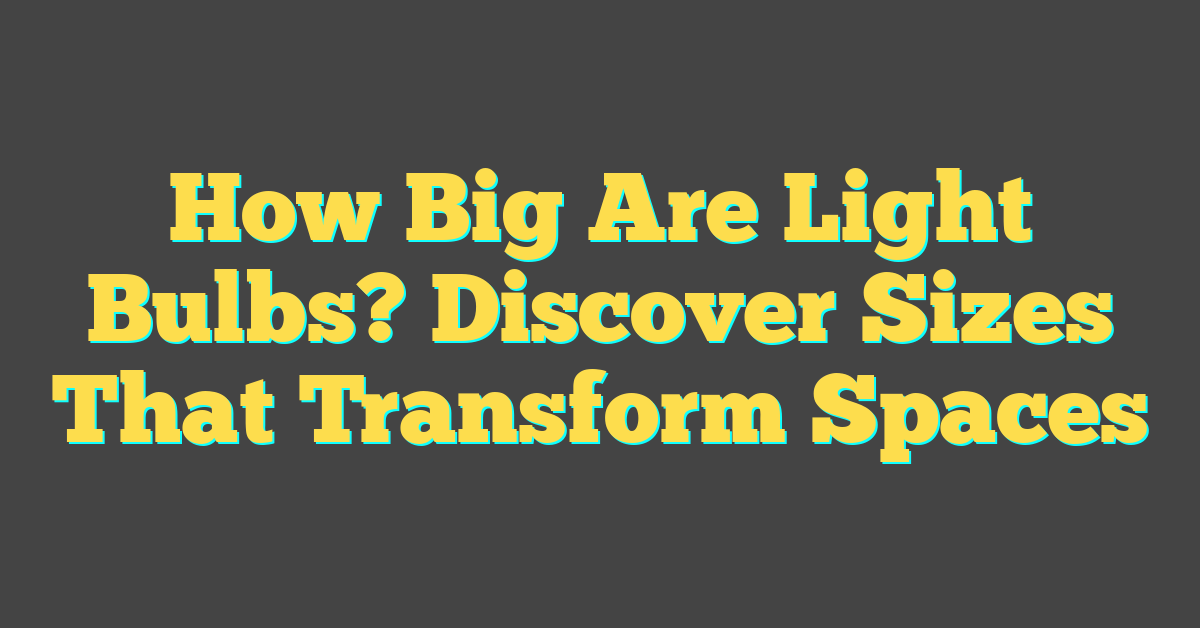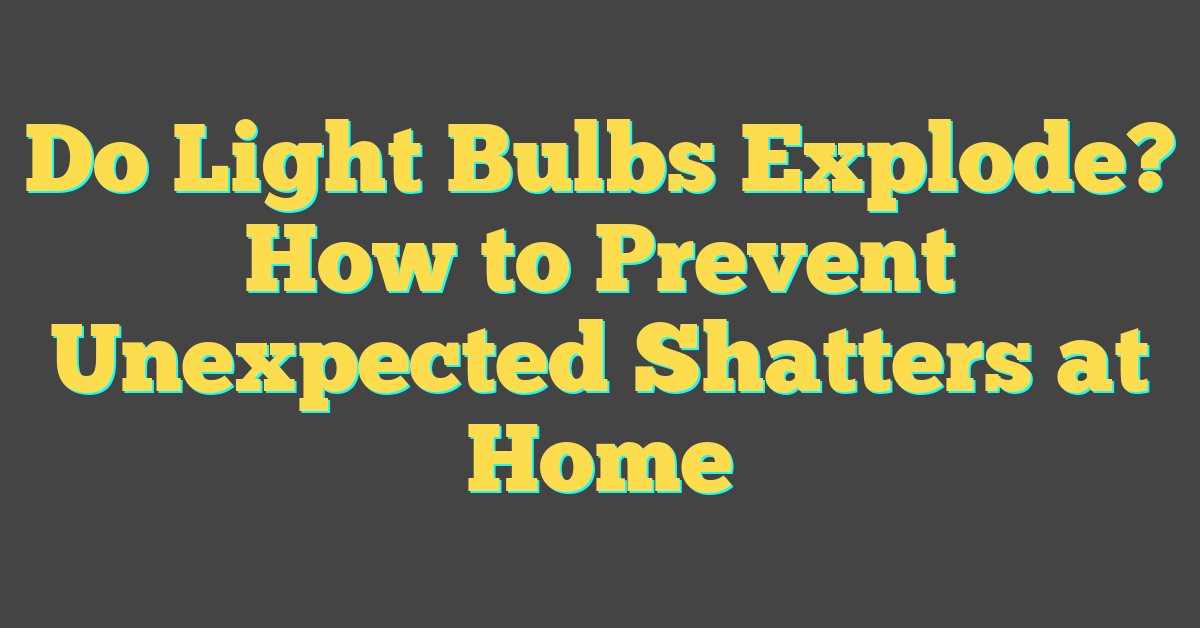Ever wandered down the lighting aisle and felt overwhelmed by the sheer variety of light bulbs? You’re not alone. Size matters when it comes to lighting your space, and there’s more to it than just fitting into the lamp socket.

From tiny LEDs to grand chandeliers, light bulbs come in an astounding array of sizes and shapes. But why the diversity, and how do you know which size is right for your needs? Let’s shed some light on the subject and find out just how big light bulbs can get.
Factors to Consider when Choosing Light Bulb Sizes
When diving into the world of light bulbs, you’ll quickly find that size does matter. Picking the correct size is key to ensuring that your lighting solution is both practical and aesthetically pleasing. To make a well-informed decision, let’s shed some light on the factors you need to consider.
Fixture Compatibility is paramount. You don’t want to end up with a bulb that won’t fit into your existing fixtures. Be sure to check:
- The base size of the bulb
- The maximum wattage your fixture can handle
- The physical space available around the fixture
Next, consider the Purpose of the Light. The size of the bulb can influence the ambience and functionality of your space. Think about what you’re lighting:
- For reading or task lighting, you might need a larger or more focused light source.
- For mood lighting, smaller bulbs with a softer glow could be more appropriate.
Energy Efficiency is another crucial aspect. With the increasing trend toward green living, you’ll want to keep an eye out for:
- LED options that offer more light with less power
- The lumens-to-watt ratio to get the best bang for your buck in terms of energy consumption
Lastly, the Aesthetic Appeal makes a world of difference. Your bulb’s size will affect the overall look of your room:
- Larger, decorative bulbs can be a statement piece
- Smaller bulbs may blend in more and maintain a minimalistic style
Keep in mind, light layering with a mix of different bulb sizes can enhance the dynamics of your space. As you ponder these factors, you’re on track to finding the perfect bulb to brighten your abode.
Understanding Bulb Size Terminology

In the luminous world of lighting, getting to grips with bulb size terminology is pivotal for any home DIY enthusiast. Let’s shed some light on the letter and number codes you’ll often encounter.
Bulb shape codes, indicated by a letter or letters, tell you about the form of the bulb. For example:
- A denotes the standard shape we all know and love, the “A-shape” bulb.
- G stands for globe, describing bulbs that are spherical in nature.
- C signifies a candle or conical shape, often seen in chandeliers.
Then, there are bulb size codes, usually represented by a number following the shape code. This number corresponds to the bulb’s diameter at its widest point, measured in eighths of an inch. For instance:
- An A19 bulb has a diameter of 19 eighths of an inch, or 2.375 inches.
- A G25 globe bulb measures 25 eighths of an inch, making it a tad over 3 inches.
Here’s a table that breaks down some common sizes:
| Bulb Type | Diameter (inches) |
|---|---|
| A19 | 2.375 |
| G25 | 3.125 |
| C7 | 0.875 |
Don’t misunderstand wattage as an indicator of size — it measures power consumption and brightness, a totally different aspect of bulb selection.
Mastering this terminology empowers you to pair the perfect bulb with any fixture, ensuring not only that it fits but that it also fulfills the intended aesthetic and functional role. When planning your next lighting project, jot down fixture measurements and keep in mind how spatial distribution affects your room’s vibe.
« Can Light Bulbs Be Used Outside? Outdoor Lighting Tips Revealed
Is There a Problem with LED Light Bulbs? Uncovering the Truth »
Remember, overhead lights might call for wider bulbs that cast light broadly, whereas task lighting benefits from narrower, more focused bulbs. Always double-check compatibility to avoid any bright mistakes. With this knowledge tucked under your belt, you’re well on your way to becoming a savvy illuminator in the artful dance of light layering.
Common Light Bulb Sizes and Shapes

When you’re on the hunt for the perfect light bulb, you’ll encounter a myriad of sizes and shapes. Knowing what’s out there can save you a world of frustration at the hardware store. Let’s illuminate some of the most common types you’re likely to come across.
First off, A19 bulbs are your standard go-to for most household lamps. If you’ve ever replaced a lamp bulb, chances are it was an A19. A little larger and longer, A21 bulbs fit the bill for spaces that need a bit more oomph in their illumination. For a sleeker, more modern vibe, T10 bulbs are tubular wonders that are often seen providing ambiance behind a bar or highlighting an architectural feature.
Now let’s switch gears and talk decorative. Candelabra bulbs (C7 or C9) add a dash of elegance and are often seen twinkling in chandeliers, while Globe bulbs (G25 or G30) make a statement in bathrooms and vanity areas with their round, mirrored surfaces.
| Bulb Type | Common Uses |
|---|---|
| A19 | Standard household lighting |
| A21 | Reading lamps, workspace |
| T10 | Accent lighting, decoration |
| C7/C9 | Chandeliers, decorative lamps |
| G25/G30 | Bathroom vanities, pendant lights |
For outdoor spaces, PAR38 bulbs are your heavy-duty players, built to withstand the elements while brightly lighting up your porch or garden. The “PAR” stands for “parabolic aluminized reflector”, talking to their focused beam of light – perfect for security or spotlighting.
While these are some of the mainstream bulbs, innovation hasn’t stopped. The era of LEDs invites even more variety, with thinner, more energy-efficient designs. Like the slim S14s, which are gaining popularity for their edison-like appeal and long life spans.
Remember, though, bulbs are more than their looks. Each shape and size offers a different throw of light, which can influence the atmosphere and functionality of any room. So take your time, and don’t be afraid to mix things up until you’ve nailed down the ambiance you’re aiming for. Keep in mind the measurements of your fixtures and the layering technique discussed earlier.
How to Measure the Size of a Light Bulb

When you’re knee-deep in a home DIY project, knowing how to properly measure a light bulb can save you both time and frustration. Get your tape measure ready because you’re about to become a light measuring pro!
First things first, understand the bulb’s code. Light bulb codes are not just random letters and numbers; they’re the key to the bulb’s size. For example, the ‘A’ in A19 refers to the bulb shape, while ’19’ indicates the bulb’s diameter in eighths of an inch. So, to measure your bulb, you’ll need to do some simple math.
Start by measuring the diameter of the bulb at its widest point. Take this measurement in inches, then multiply by eight to convert this number to eighths of an inch. For a globe bulb, that’s often the complete circumference, so be precise!
If you have a decorative bulb, like a candelabra, you might notice it has a more complex shape. Look for the widest part of the bulb—excluding any decorative flare—and measure across in inches. Divide this measurement by the bulb’s shape code number to get the standard size. It’s crucial to check these measurements against product specifications or packaging to ensure a perfect fit.
Length is another crucial dimension, especially for tubular bulbs like the T10. Measure from the base to the tip of the bulb (don’t include any pins or screw bases). These measurements determine whether the bulb will fit in the depth of your lamp or fixture.
Here’s a snapshot of standard measurements for common bulbs:
| Bulb Type | Diameter (in eighths of an inch) | Length (inches) |
|---|---|---|
| A19 | 19 | Varied |
| A21 | 21 | Varied |
| T10 | 10 | Varied |
| PAR38 | 38 | Varied |
As you’re swapping out bulbs or updating your lighting, don’t just go by look and feel. An accurately measured bulb will ensure that your space is illuminated just the way you want, without any unwelcome surprises. Keep in mind the harmony between function and form—your lighting should be as aesthetically pleasing as it is practical.
The Largest Light Bulbs on the Market

When you’re knee-deep in your latest home DIY project or looking to make a statement with your lighting, size can be a critical factor. In the realm of light bulbs, going big can mean anything from increased luminescence to a bold decorative touch. Large bulbs have a profound impact on ambiance and design, blending function and fashion.
Let’s shine a light on some of the behemoths of the bulb world. Grandiose globe bulbs commonly used in commercial spaces or outdoor lighting projects can exceed 12 inches in diameter. These impressive globes not only provide ample light but also serve as a focal point in any setting. In contrast, antique-style Edison bulbs have gained popularity for their visual appeal and can come in lengths of up to 15 inches. They exude a warm, vintage glow that’s as much about mood as it is about illumination.
In industrial settings, the need for substantial lighting solutions leads to the use of high-intensity discharge (HID) bulbs. These can be particularly large, both in length and width, to cover expansive areas effectively. High-wattage HID bulbs are typically found in warehouses and outdoor stadiums.
Here’s a quick glimpse at the larger end of the bulb spectrum:
| Bulb Type | Approximate Diameter | Approximate Length |
|---|---|---|
| Globe Bulbs | Up to 12 inches | Varies |
| Edison Bulbs | Varies | Up to 15 inches |
| HID Bulbs | Varies | Varies |
Note: Measurements may vary by manufacturer and specific bulb usage.
While these large bulbs are eye-catching, remember that your lighting fixtures need to be able to handle such sizes. Always check fixture compatibility before making your purchase. And don’t forget—bigger bulbs mean more space for light to spread, so they are ideal for bringing life to large, dimly lit areas in your home or workspace.
When selecting a large bulb, consider not just the size, but also the lumens, color temperature, and energy efficiency. After all, larger light bulbs can mean a brighter space, but they should also align with your overall lighting needs and design aesthetic. Whether it’s the soft glow of an oversized Edison bulb over your reading nook or the commanding presence of a globe bulb in the foyer, you’re not just lighting a space, you’re elevating it.
Conclusion
You’ve seen how light bulbs can range from the compact to the colossal, each size bringing its own unique flair to the spaces they illuminate. Whether you’re drawn to the statement-making grandeur of oversized globe bulbs or the nostalgic charm of elongated Edison lights, there’s a bulb out there to fit your vision. Remember to measure twice and install once, ensuring your chosen giants are a perfect match for your fixtures. And while size does matter, don’t forget to weigh in the brightness, hue, and energy consumption to make your space shine just right. Now you’re equipped to light up your world, no matter how big you dream.
Frequently Asked Questions
What are the largest light bulbs available on the market?
The largest bulbs include grandiose globe bulbs over 12 inches in diameter, antique-style Edison bulbs up to 15 inches long, and large high-intensity discharge (HID) bulbs for industrial spaces.
How do large light bulbs affect ambiance and design?
Large bulbs, especially grandiose globe and antique-style Edison ones, create a statement and can serve as a focal point, adding to the ambiance and aesthetic of any room with their size and unique glow.
Can I use grandiose globe bulbs in any fixture?
No, you must check the fixture compatibility due to their size. The approximate measurements for these larger bulbs are provided in a table within the article to help with selection.
What should be considered when selecting a large light bulb?
When choosing a large bulb, consider factors like lumens for brightness, color temperature for the hue of light emitted, and energy efficiency for cost and environmental impact.




